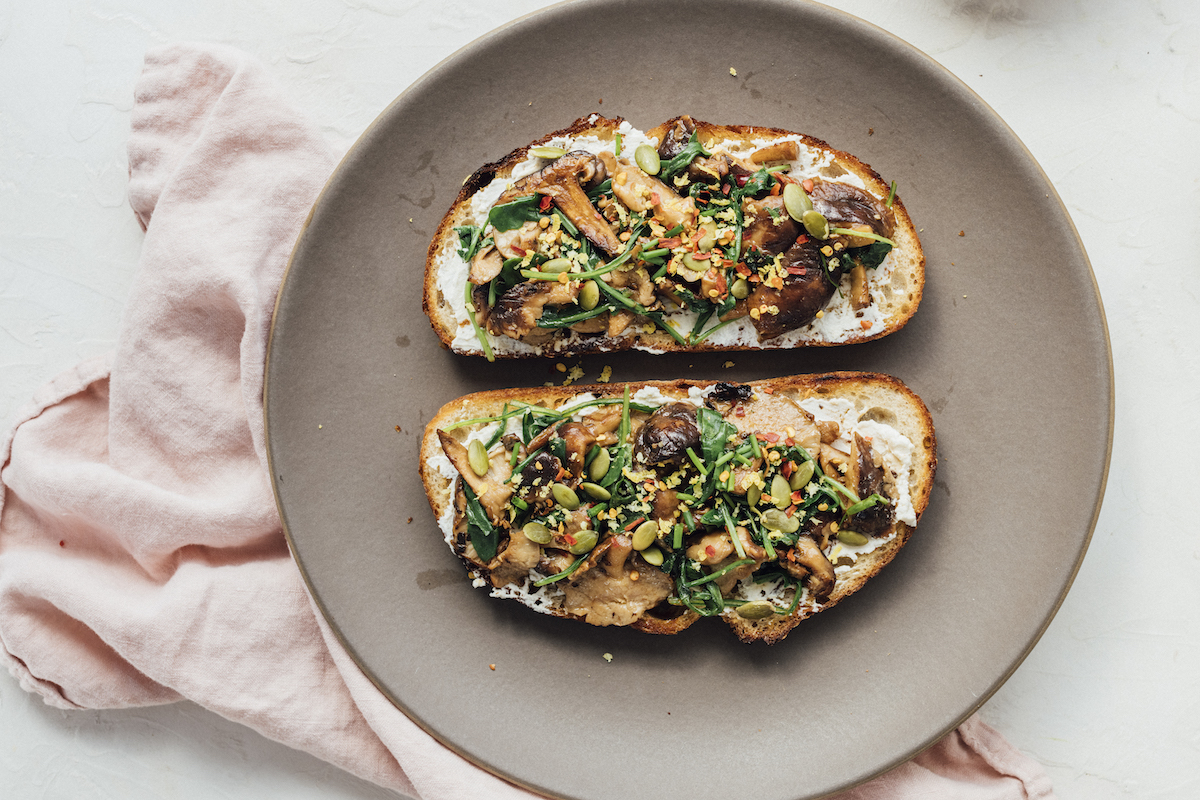Hormone health is vital to our well-being. As the body’s chemical messengers, hormones are integral to a wide variety of processes and symptoms. Throughout every stage of life, hormones play a role. They regulate everything from growth to sex drive, reproduction, metabolism, skin health, and more. Produced in the endocrine glands, these influential chemicals travel through the bloodstream to tell tissues and organs what to do. They help control what (and when) certain processes happen in the body. Although very powerful, hormones are equally sensitive. This means that they are easily influenced by lifestyle factors: diet, exercise, stress, sleep, and more. That’s why incorporating foods that lower estrogen into your daily meals can be so key.
Read on to learn more about hormones from imbalances to endocrine disruptors, how diet impacts estrogen, and the 10 foods that lower estrogen.
Featured image from our interview with Roxana Saidi by Suruchi Avasthi.



Hormone Imbalances Are More Common Than You Think
These days, hormone irregularities are remarkably common. Studies show that upwards of 80% of women suffer from hormone imbalances. PCOS (polycystic ovary syndrome), for example, affects approximately five million women in the United States. That makes this condition one of the most common hormonal endocrine disorders among women of reproductive age.
In essence, when you have a hormonal imbalance—which, by the way, commonly happens in men as well—you have too much or too little of a particular hormone. When your endocrine glands don’t secrete enough (or too much) of a particular hormone, things go awry. From high cortisol to low testosterone, fluctuations in hormone levels are usually a result of lifestyle factors. And while hormone levels are supposed to fluctuate throughout your lifetime (hello, pregnancy!), chronically high or chronically low levels wreak havoc.
The 6 Primary Hormones
There are a few major hormones in the body:
- Cortisol is our main stress hormone.
- T3 and T4 are our two primary thyroid hormones.
- Melatonin controls our sleep and wake cycles (i.e., our circadian rhythm).
- Progesterone and testosterone are involved in reproduction; they’re often called the “female” and “male” hormones, as progesterone is mostly produced by the ovaries, and testosterone is mostly produced in the testicles.
- Insulin is required for the cells in your body to properly use glucose in your bloodstream.
- Estrogen plays an incredibly important role in the functioning of both female and male bodies.
What is estrogen?
Commonly referred to as the “female sex hormone,” estrogen is one of the most essential chemicals in all bodies—men included. While estrogen plays many roles and has multiple uses, it is a predominant leader in the female reproductive system.
Along with regulating the menstrual cycle, estrogen affects the urinary tract, heart and blood vessels, bones, breasts, skin, hair, the brain, and more. A woman’s ovaries make a majority of estrogen, but the adrenal glands and fat cells make estrogen, too.
Your body makes three different types of estrogen:
- Estradiol. The most common type in women of childbearing age.
- Estriol. The main estrogen involved in pregnancy.
- Estrone. The only estrogen your body makes after menopause.
Why do we need estrogen?
Beyond its importance for developing and maintaining the reproductive system, estrogen is necessary for childbearing and a healthy, regular menstrual cycle. We also need estrogen to maintain bone density, positive mood, and healthy cholesterol levels. Furthermore, estrogen contributes to cognitive function and overall vitality.
Download our cycle syncing planner to support your body throughout the month.
Endocrine Disruptors
Like any kind of imbalance in the body, erratic estrogen levels can cause adverse reactions. Most notably, irregular menstruation, mood changes in women, and infertility/erectile dysfunction in men. For an imbalance to occur, estrogen is either too high or the hormones that balance estrogen are too low. For example, this could mean that progesterone in women is too low and in men, testosterone is too low. Hormonal birth control certainly impacts estrogen, potentially causing hormonal imbalances long after you’ve stopped taking it.
Furthermore, endocrine disruptors (natural and synthetic compounds that interfere with the function of hormones) negatively affect hormonal balance. These are found in everything from plastic water bottles to personal care products, receipts, pesticides, and more. Even in small doses, they can leave a lasting impact. When possible, purchase natural cleaning products, say no to printed receipts, switch to a reusable water bottle, and use beauty products without harmful chemicals.
Estrogen Dominance: Signs and Symptoms
When the levels of estrogen are chronically high (especially in comparison to other sex hormones that circulate in the blood), women are commonly diagnosed with estrogen dominance. Unfortunately, without proper balance with other sex hormones, estrogen dominance can lead to an array of unpleasant symptoms:
- Hair loss
- Low sex drive
- Poor sleep quality
- Cold hands and feet
- Digestive issues
- Tender or swollen breasts
- Fatigue
- Depression
- Non-cancerous breast lumps
High levels of estrogen can also cause PCOS, uterine fibroids, irregular menstrual cycles, and thyroid dysfunction. Men may also suffer from estrogen-related issues. Additionally, elevated estrogen is a risk factor for breast, ovarian, and endometrial cancer in women, as well as prostate and breast cancer in men.
The good news is, many lifestyle changes can lower estrogen levels naturally. Beyond removing endocrine disruptors from your home, incorporating meditation and finding joyful ways to move your body are key. Furthermore, eating a low-estrogen diet is a practical, sustainable way to help balance hormones.
How Diet Impacts Estrogen
Research shows that specific diets are linked to high estrogen levels. For example, the Standard American Diet (SAD), which is characterized by conventional red meat and dairy, processed foods, sugary treats, and refined grains can cause hormone imbalance.
More than ever, it’s important to take inventory of what you’re putting in your body. Conventional animal products (particularly, dairy, chicken, and fish) contain high amounts of estrogen. In essence, hormones have been used for decades to accelerate animal growth. Synthetic estrogen and testosterone are the most common, unfortunately. Not only are these synthetic hormones harmful to the animals and us—consumers—but they contribute to environmental issues, too.
Eat for Hormone Balance
If you’re regularly consuming conventionally raised animals, consider making the switch. And rest assured, you can eat animals without added hormones on a budget. To start, look for labels like ‘rBST free,’ ‘organic,’ and ‘pasture-raised.’ Otherwise, simply scaling back on your animal consumption—in lieu of more plant foods—can help balance excess estrogen in the body.
On a regular basis, build your snacks and meals around fresh fruit, vegetables, nuts, seeds, legumes, and nutritious, minimally processed grains. Healthy fats from plant foods are also important. Think almonds, avocados, Brazil nuts, chia seeds, coconut, sunflower seeds, tahini, and walnuts. Lastly, load up on plenty of leafy greens to help with the body’s natural detoxification pathways. A well-functioning liver is imperative for breaking down excess estrogen. Veggies like broccoli, kale, cabbage, collard greens, and bok choy all contain compounds that support estrogen receptors.
10 Foods That Lower Estrogen
The million-dollar question: Can you lower your estrogen levels through diet? The long-short is yes—it is possible. Consuming these 10 foods that lower estrogen can aid in removing excess estrogen from the body as well as contribute to the building blocks of producing other necessary hormones.
- Arugula
- Avocado
- Broccoli
- Carrots
- Coconut Oil
- Eggs
- Mushrooms
- Pomegranates
- Red grapes
- Whole grains
Arugula
Among other leafy greens, arugula has both anti-cancer and estrogen-blocking properties. It’s also high in vitamin C, an immune booster. Although it’s a bitter green, a simple massage with coconut oil and lemon juice helps remove some of its bite.
Avocado
Research shows that avocados can help reduce the absorption of estrogen and boost testosterone levels. They also improve heart health and aid in satiety. We need enough healthy fats to make hormones, and avocados are a great source of hormone building blocks.
Broccoli
Cruciferous veggies, like broccoli, Brussels sprouts, and cauliflower are incredible at helping our livers metabolize estrogen. Adding in a variety of these ingredients aids in hormonal balance.
Honey Roasted Carrots with Spicy Citrus, Sage & Pepitas
Raw carrots, in particular, are incredible at detoxing excess estrogen from the body. Made of mostly indigestible fiber, carrots can help excrete excess estrogen. Just one to two raw carrots (not baby carrots), per day, will do the trick.
These Lemon Tarts with Orange Blossom Whipped Cream Are Magically Dairy-Free
Coconuts contain a variety of beneficial compounds, like minerals and medium-chain fatty acids. Coconut oil has been shown to protect the liver from excess estrogen (and toxins, in general). With a buildup of toxins that can lead to estrogen dominance in the body, coconut oil is a versatile ingredient to add to your morning matcha, incorporate into baking, and use as the healthy fat in soups. Look for organic, cold-pressed, and unrefined coconut oil.
Eggs
To give your liver a helping hand (to boost detox pathways), eating foods that contain sulfur ultimately aids in removing excess estrogen. Along with onions and garlic, egg yolks are a wonderful source of sulfur. Pasture-raised eggs also contain healthy fats, which are critical for hormone production.
Mushrooms
Oyster mushrooms, in particular, contain compounds that may block aromatase. Aromatase’s primary function is to produce estrogens. Therefore, mushrooms could aid in reducing estrogen in the body. In addition to culinary mushrooms, functional mushrooms may help balance hormones in the body.
Kale, Persimmon, & Pomegranate Salad
Antioxidant-rich pomegranate seeds contain a natural compound that can inhibit the enzyme that converts estrone into estradiol. In other words, pomegranates can help modulate excess estrogen in the body.
Red Grapes
In the skin of red grapes is resveratrol, a chemical that works to block estrogen production. Along with acting as an antioxidant, resveratrol helps flush excess estrogen from the body. Foods rich in resveratrol can also help reduce levels of testosterone.
Whole Grains
When it comes to choosing grains, make sure to buy 100% whole grain, preferably in their whole state. For example, quinoa seeds or whole oats instead of instant oatmeal or wheat bread. Whole grains retain a rich nutrient profile, including fiber and hormone-balancing B vitamins. Whole grains stabilize blood sugar, important for estrogen balance.









